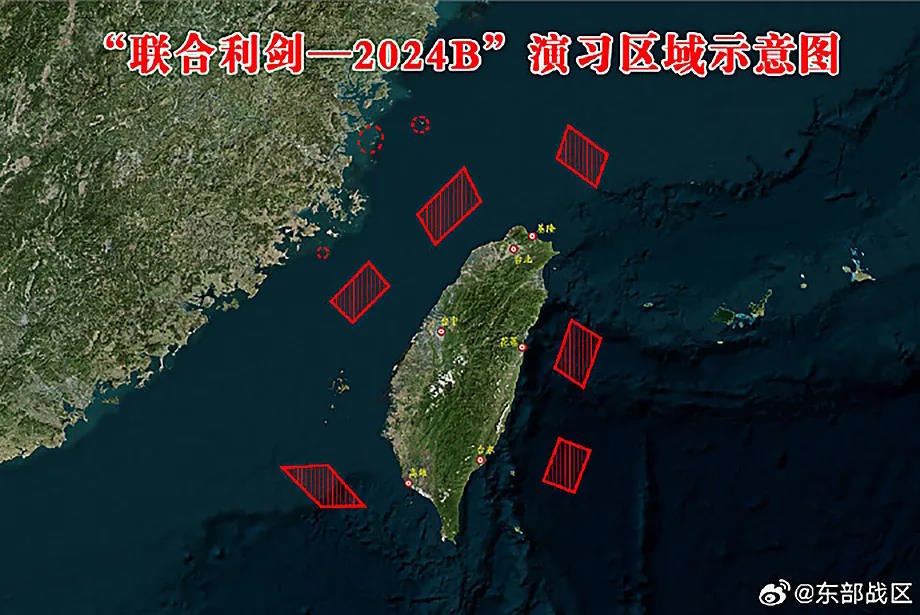Four days after Taiwan celebrated its National Day and its president reaffirmed the democracy and sovereignty of the nation, China has launched military exercises around the island.
This Monday, the Chinese army announced a new invasion drill involving the navy, air force, and rocket force, which includes large stockpiles of short and medium-range ballistic missiles, such as the Dongfeng-17, capable of maneuvering at hypersonic speed (five times the speed of sound), making it difficult to detect by defense systems.
A spokesperson for the Eastern Theater Command of the People's Liberation Army of China (PLA), the unit leading the maneuvers, stated that Beijing's show of force is a "strong deterrent measure" against the "behavior of the separatist independent forces of Taiwan seeking independence."
The command released a map on its website showing the nine areas around Taiwan where the exercises will take place: two on the east coast of the island, three on the west coast, one to the north, and three on the small islands controlled by Taipei off the southern coast of China.
Almost daily, Beijing sends planes and ships to conduct maneuvers near Taiwan. However, these latest exercises represent the fourth largest war drills since August 2022 when the military of the Asian superpower even launched ballistic missiles that flew over the island in response to the visit to Taipei by the then Speaker of the US House of Representatives, Nancy Pelosi.
In April 2023, when former Taiwanese President Tsai Ing-wen traveled to California to meet with then-House Speaker Kevin McCarthy, Beijing rehearsed launching combat aircraft from aircraft carriers. In May of this year, the Chinese army paraded planes carrying real missiles that simulated attacks on military targets, while the ships practiced a naval blockade.
The maneuvers this week are not expected to involve live fire and aim to practice a rapid total blockade isolating the self-governing island from quick assistance from its main ally, the United States. Similar to May, Chinese fighter jets will conduct simulated attacks mainly against the east coast of Taiwan, which is on the other side of a mountain range and has few suitable spaces for an amphibious landing. Therefore, Taipei has placed a significant part of its military infrastructure there.
While Chinese state media shared the progress and details of the new maneuvers on Monday, Taiwan's Ministry of Defense also showcased the deployment of warships and military vehicles to respond to Beijing's new threat.
Lai Ching-te in another statement, considered by Beijing as a "separatist troublemaker."
Lai stated that the Chinese military exercises aim to "disrupt regional peace and stability" and constitute an "attempt to coerce China's regional neighbors through the use of force."
Earlier this month, during the celebrations for the 75th anniversary of the People's Republic of China, President Xi Jinping mentioned the island that Beijing considers a separatist province in his speech. "Taiwan is sacred territory of China," declared the Chinese leader.
Xi, as he almost always does when mentioning Taiwan in his speeches, warned that the "reunification of the motherland is inevitable," even by force if necessary. Tensions between both sides of the strait have escalated since Lai formally took the reins of the autonomous island last May, replacing Tsai Ing-wen, who has been a major critic of the Chinese regime in recent years.
While Xi reiterated that Taiwan was an indisputable part of Chinese territory, from Washington, the island's main international supporter and arms supplier, it was announced that President Joe Biden had approved a $567 million aid package to enhance Taiwan's defense capabilities.
During his term, Biden has greenlighted the delivery of several military aid packages to Taipei, which, however, has protested delays in the arrival of these weapons due to increased US focus on aiding the Ukrainian military in defending against the Russian invasion.
According to a report by the Cato Institute, a Washington-based think tank, supply bottlenecks had delayed the delivery of weapon systems to Taiwan worth over $20 billion. Additionally, several Taiwanese government sources claim that some of the US military equipment received is "unusable."
In two deliveries between November 2023 and March of this year, 120 water-damaged pallets containing over 3,000 body armor plates and 500 tactical vests were received, "soaked and covered in mold." This was compounded by a large portion of the 2.7 million rounds of ammunition received being expired.
